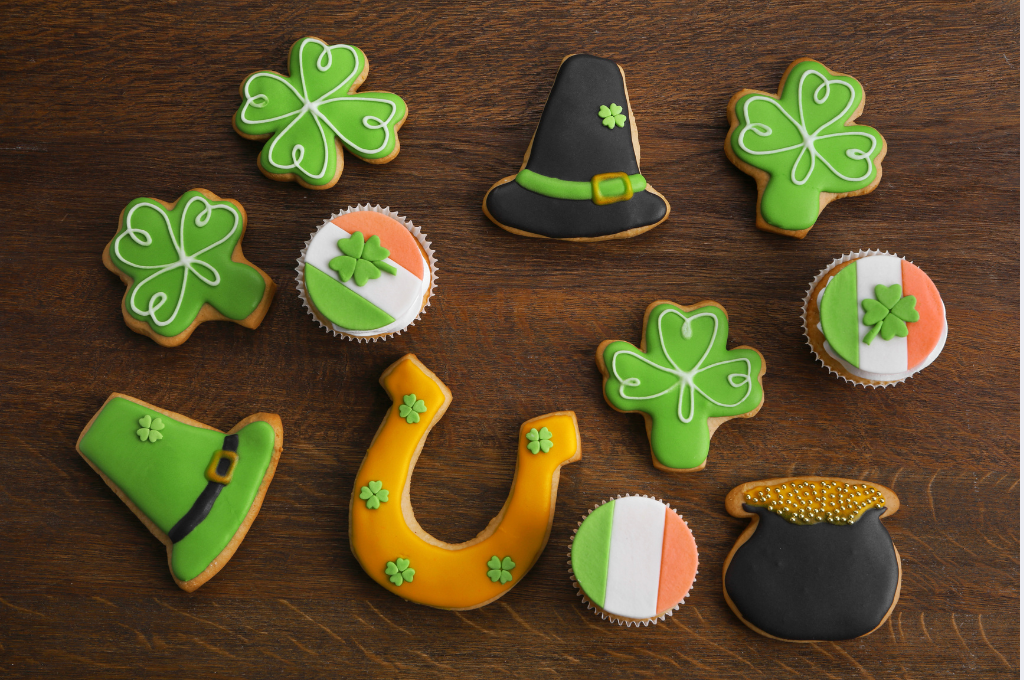Breathtaking scenery, good beer, sheep, leprechauns hiding pots of gold at the end of the rainbow, traditional music and dance – the associations with Ireland can be as numerous as the shades of green in the Irish landscape. During his stay on the Emerald Isle in 1959, American musician Johnny Cash wrote a song called “Forty Shades of Green”, so it is safe to assume that there are at least forty of them 😉. Green is also the colour associated with St Patrick’s Day, the celebration of the patron saint of Ireland, whose death anniversary is lavishly commemorated there every year on March 17.
It is not only the Irish, for whom it is a national holiday and a day off work, who celebrate, but everyone who feels Irish revels in the day’s many festivals, street parades and in pubs, drinking beer and Irish whiskey. With Irish emigration dating back to the early Middle Ages, it is estimated that up to 80 million people worldwide have Irish roots! Traditionally, green clothes are worn and green beer is drunk on St Patrick’s Day, and many famous landmarks such as the Leaning Tower of Pisa, Sydney Opera House and Burj al-Arab in Dubai are illuminated in green. A special green dye is also pumped into American rivers on March 17, for example in New York and Chicago (although the authorities say it is perfectly safe, a growing number of eco-activists are protesting against the custom).
But before you start looking for green T-shirts or other items of clothing, let’s take a look at some of the most famous Irish symbols that are protected by intellectual property law.
Perhaps the most recognisable attribute of Saint Patrick is the shamrock, which the patron saint of Ireland is said to have used to explain the nature of the Trinity to the first Irish Christians. The shamrock can be seen in the logos of many Irish sports teams, government organisations and companies, as well as on the uniforms of Irish soldiers serving abroad. In 1985, the Irish government officially adopted it as the national emblem, to replace, on less official occasions, the Emerald Isle’s coat of arms: a golden harp with silver strings on a blue shield. The image of this instrument, deeply rooted in Irish culture, has appeared on coins, official seals and official documents for centuries, while the crest itself refers to the harp of the Irish king Brian Boru, who lived at the turn of the 11th century.
National symbols as registered trademarks
Because both symbols are so closely associated with Ireland, they are protected as trademarks under the Irish Trade Marks Act, 1996 (Sections 9, 62, 97 and 98). Neither the shamrock nor the harp can be used without official permission from the Department of Enterprise, Trade and Employment. The policy for granting permission to use the State Emblem and Coat of Arms is very restrictive and they can only be used commercially where it can be clearly demonstrated that there is a real and substantial connection between the goods in question and Ireland. At the same time, Section 98 of the Act confers extraterritorial powers on the Minister; this provision is intended to prevent and restrict the registration or use, in respect of goods manufactured outside the State, of any trademark or other sign or description which falsely indicates or is likely to lead to the belief that particular goods originate from Ireland.
In 1985, the harp, the shamrock and a number of variants thereof were registered with the World Intellectual Property Organisation (WIPO). They therefore enjoy international protection under Article 6ter of the Paris Convention for the Protection of Industrial Property, which provides that coats of arms and other national emblems, just like state flags, enjoy absolute protection irrespective of the goods and services they are registered for. Many Irish companies use trademarks based on the symbols of the harp and the shamrock which are registered with the Irish Patent Office. For example, the shamrock can be found in the logo of the Irish airline Aer Lingus, while the harp appears in the logo of the producer of the drink that is an integral part of St Patrick’s Day festivities.
How do you share the harp?
In 1759, Arthur Guinness began brewing beer at the St James Gate Brewery in Ireland and ten years later he first exported it overseas to the UK. To this day, Guinness beer remains one of Ireland’s most important exports, with an annual turnover in excess of $2.6 billion. On St Patrick’s Day alone, more than 13 million pints are consumed worldwide! The harp appeared on the label of the first bottle produced in 1862 and was registered as a Guinness trademark in 1876 (U.K. Reg. No. 0000004474A). When the company launched its first lager in 1960, it was, unsurprisingly, called “Harp”.
Interestingly, attempts by the Irish government to register the harp as a state symbol raised concerns that this might infringe the Guinness trademark. The matter was further complicated by the fact that there were many graphic variants of the instrument in official use, ranging from a 14-string harp on coins to a nine-string harp on official letterheads. The predominant image was a gold harp with silver strings on a blue background, but there were also other versions in different colours. It was felt that it would be better to register a “generic harp” rather than a number of specific designs, as minor changes to the number of strings, the colour of the harp or the background would be sufficient to circumvent the law. To ensure maximum protection, the Irish Attorney General’s Office recommended that two harps, facing in both directions, be registered with WIPO. However, the Irish government was concerned that Guinness might challenge this: after all, the company had been using the right-facing harp symbol for more than half a century before the Irish state was even established.
However, the law firm representing the government said that under current rules, mirror images of the harp symbol could not be filed with WIPO. Registering the right-facing harp could prevent Guinness from registering its trademark in territories where it did not trade at that time but might wish to do so in the foreseeable future. Finally, in order to distinguish the national coat of arms from the Guinness harp, the Irish government turned its harp in the opposite direction and registered with WIPO a “generic” nine-string harp facing only one way – to the left.
Go for accuracy over luck!
When it comes to trademarks, never rely on luck, even if it is guaranteed by a three- or four-leaf clover! Failure to adequately protect intellectual property can cost an entrepreneur a pot of gold! Guinness knows this well, with its innovation over the years reflected in an extensive portfolio of patents covering various aspects of brewing, packaging, dispensing systems and technologies designed to enhance the quality and experience of drinking Ireland’s most famous beer. The producer has also claimed marketing and branding strategies to enhance Guinness brand recognition, including advertising slogans.
Perhaps one of Guinness’ most famous inventions is the widget, patented in 1969 (https://en.wikipedia.org/wiki/File:UK_Patent_1266351.pdf). This is a hollow plastic ball with a small opening, which is placed in cans and bottles. During filling, liquid nitrogen is added to form a gaseous mixture with carbon dioxide. When the can is closed, pressure is created therein, forcing the gas and liquid inside the widget; when the pressure drops after the can is opened, the gas and liquid escape from the ball at high speed through the opening and mix with the beer, creating the distinctive thick, creamy head characteristic of Guinness poured straight from the keg. Sláinte!



